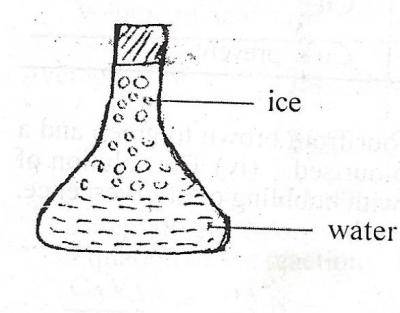150cm3
75cm3
30cm3
25cm3
Correct answer is A
Using the formula, CAVACBVB=NANB, we have
0.1×VA0.3×25=21
VA=0.3×25×20.1×1
VA=150cm3
Which of the following statements best explains the difference between a gas and a vapour?
Unlike gases, vapours are liquids at room temperature
Unlike gases, vapour can easily be condensed into liquids
Unlike gases, vapour is readily converted into solids
Vapours are generally denser than gases
Correct answer is B
Vapour is the equilibrium state between the gases and liquid, and it can bounce back to its original form, liquid with constant temperature and pressure exerted on it.

The water is at lower temperature than the ice
Energy is absorbed when the ice changes to water
Energy is released when the ice changes to water
The water molecules vibrate about a fixed point
Correct answer is B
Heat energy near the ice gets absorbed into the ice. The energy breaks the bonds of the ice, causing it to melt into liquid water. On other words, when ice melts, the energy gets absorbed into the water.
The following factors would contribute to environmental pollution except
production of ammonia
manufacture of cement
photosynthesis
combustion
Correct answer is C
Photosynthesis is the process of food-making in plants, it doesn't have any by-products that pose a threat to the environment. Infact, the plants use our waste product of respiration (Carbon dioxide) and uses it for the photosynthetic process and gives off oxygen as by-product.
The most suitable substance for putting out petrol fire is
water
carbon(IV) oxide
fire blanket
sand
Correct answer is B
In order to extinguish a petrol fire, you have to cut off the oxygen. This can be done by using carbon dioxide gas to dilute the oxygen available and stop the burning.
WAEC Subjects
Aptitude Tests